Preparation of Sn-Doped Ga2O3 Thin Films and MSM Ultraviolet Detectors Using Magnetron Co-Sputtering
Abstract
1. Introduction
2. Materials and Methods
3. Results and Discussion
3.1. Microstructure and Component of Sn-Doped Ga2O3 Thin Films
3.2. Electrical Properties of Sn-Doped Ga2O3 Thin Films
3.3. Optical Performance of Sn-Doped Ga2O3 Thin Films
3.4. Performance of Sn-Doped Ga2O3 Thin Film MSM Ultraviolet Detector
4. Conclusions
Author Contributions
Funding
Institutional Review Board Statement
Informed Consent Statement
Data Availability Statement
Conflicts of Interest
References
- Chen, H.; Liu, K.; Hu, L.; Al-Ghamdi, A.A.; Fang, X. New concept ultraviolet photodetectors. Mater. Today 2015, 18, 493–502. [Google Scholar] [CrossRef]
- Li, Z.; Li, Z.; Shi, Z.; Zhu, P.; Wang, Z.; Zhang, J.; Li, Y.; He, P.; Zhang, S. ALD prepared silver nanowire/ZnO thin film for ultraviolet detectors. Mater. Today Commun. 2023, 37, 106974. [Google Scholar] [CrossRef]
- Xin, Y.; Zhang, W.; Gao, Z.; Xiu, J.; Yu, D.; Li, Z.; Zhu, M. Preparation of ZnGa2O4-based deep ultraviolet photodetector with high photodetectivity by magnetron sputtering. Vacuum 2024, 224, 113165. [Google Scholar] [CrossRef]
- Xu, J.; Zheng, W.; Huang, F. Gallium oxide solar-blind ultraviolet photodetectors: A review. J. Mater. Chem. C 2019, 7, 8753–8770. [Google Scholar] [CrossRef]
- Senthilkumar, L.; Raja, S.; Babu, R.; Vasuki, G. Enhanced electrical and optoelectronic properties of W doped SnO2 thin films. Opt. Mater. 2022, 126, 112234. [Google Scholar] [CrossRef]
- Dong, L.; Yu, J.; Zhang, Y.; Jia, R. Elements (Si, Sn, and Mg) doped α-Ga2O3: First-principles investigations and predictions. Comput. Mater. Sci. 2019, 156, 273–279. [Google Scholar] [CrossRef]
- Ken, G.; Keita, K.; Hisashi, M.; Yoshinao, K.; Bo, M.; Masataka, H.; Akito, K.; Shigenobu, Y. Halide vapor phase epitaxy of Si doped β-Ga2O3 and its electrical properties. Thin Solid. Film. 2018, 666, 182–184. [Google Scholar]
- Rekha, P.; Gopalakrishnan, N. Room temperature ammonia sensing performances of pure and Sn doped β-Ga2O3. Mater. Sci. Semicond. Process 2021, 135, 106086. [Google Scholar]
- Wang, D.; Ma, X.; Chen, R.; Le, Y.; Zhang, B.; Xiao, H.; Luan, C.; Ma, J. Solar-blind ultraviolet photodetectors based on Ta-doped β-Ga2O3 heteroepitaxial films. Opt. Mater. 2022, 129, 112491. [Google Scholar] [CrossRef]
- Esmat, F.; Elaheh, A.; James, S.; Aaron, R.; Steven, A. Deep level defects in Ge-doped (010) β-Ga2O3 layers grown by plasma-assisted molecular beam epitaxy. J. Appl. Phys. 2018, 123, 161410. [Google Scholar]
- Wang, D.; Ge, K.; Meng, D.; Chen, Z. P-type β-Ga2O3 films were prepared by Zn-doping using RF magnetron sputtering. Mater. Lett. 2023, 330, 133251. [Google Scholar] [CrossRef]
- Chu, S.Y.; Yeh, T.H.; Lee, C.T.; Lee, H.Y. Mg-doped beta-Ga2O3 films deposited by plasma-enhanced atomic layer deposition system for metal-semiconductor-metal ultraviolet photodetectors. Mater. Sci. Semicond. Process 2022, 142, 106471. [Google Scholar] [CrossRef]
- Zhang, Q.; Deng, J.; Li, R. Study on the structural, optical and electrical properties of N-doped Ga2O3 films synthesized by sol-gel method. Mater. Sci. Semicond. Process 2024, 170, 107955. [Google Scholar] [CrossRef]
- Zhang, H.; Deng, J.; Zhang, Q.; Wang, X.; Meng, J.; Xu, Z.; Li, R.; Zhang, X.; Zhang, J. Trace amount of niobium doped β-Ga2O3 deep ultraviolet photodetector with enhanced photo-response. Optik 2021, 243, 167353. [Google Scholar] [CrossRef]
- Wang, C.; Zhang, Y.C.; Fan, W.H.; Wu, W.Y.; Wuu, D.S.; Lien, S.Y.; Zhu, W.Z. Texture evolution mechanism of pulsed laser deposited in-doped Ga2O3 film affected by laser fluence and its application in solar-blind photodetector. Vacuum 2022, 205, 111469. [Google Scholar] [CrossRef]
- Lin, T.; Xie, C.; Yang, S.; Xie, J.; Liu, Y.; Chen, S.; Huang, H.; Dang, J.; Huang, R.; Duan, Y. Investigation on the Bandgap-Adjustable (Ga1−xInx)2O3 Film Prepared by Magnetron Sputtering. ACS Appl. Electron. Mater. 2024, 6, 1858–1871. [Google Scholar] [CrossRef]
- Shang, Y.; Tang, K.; Chen, Z.; Zhang, Z.; Deng, J.; Hu, Y.; Gu, K.; Cao, M.; Wang, L.; Huang, J. Growth and characterization of Ta-doped Ga2O3 films deposited by magnetron sputtering. Mater. Sci. Semicond. Process 2021, 134, 106040. [Google Scholar] [CrossRef]
- Cui, H.; Mohamed, H.F.; Xia, C.; Sai, Q.; Zhou, W.; Qi, H.; Zhao, J.; Si, J.; Ji, X. Tuning electrical conductivity of β-Ga2O3 single crystals by Ta doping. J. Alloys Compd. 2019, 788, 925–928. [Google Scholar] [CrossRef]
- Mi, W.; Li, Z.; Luan, C.; Xiao, H.; Zhao, C.; Ma, J. Transparent conducting tin-doped Ga2O3 films deposited on MgAl2O4 (100) substrates by MOCVD. Ceram. Int. 2015, 41, 2572–2575. [Google Scholar] [CrossRef]
- Zhang, Y.; Yan, J.; Zhao, G.; Xie, W. First-principles study on electronic structure and optical properties of Sn-doped β-Ga2O3. Phys. B 2010, 405, 3899–3903. [Google Scholar] [CrossRef]
- Fan, M.M.; Lu, Y.J.; Xu, K.L.; Cui, Y.X.; Cao, L.; Li, X.Y. Growth and characterization of Sn-doped β-Ga2O3 thin films by chemical vapor deposition using solid powder precursors toward solar-blind ultraviolet photodetection. Appl. Surf. Sci. 2020, 509, 144867. [Google Scholar] [CrossRef]
- Zhu, X.; Wu, Y.; Li, G.; Lu, W. In-situ composition development of Zn/In-doped Ga2O3 nanowire with ultrahigh responsivity and long-term stability for deep-UV photodetector. J. Alloys Compd. 2023, 953, 170109. [Google Scholar] [CrossRef]
- Li, J.; Wang, Y.; Li, W.; Zhang, T.; Tian, X.; Zhang, Y.; Feng, Q.; Zhang, J.; Hao, Y. Effect of tin source temperature on the β-Ga2O3 film deposited by MOCVD. J. Mater. Sci. Eng. B 2024, 302, 117221. [Google Scholar] [CrossRef]
- Mauze, A.; Zhang, Y.; Itoh, T.; Ahmadi, E.; Speck, J.S. Speck. Sn doping of (010) β-Ga2O3 films grown by plasma-assisted molecular beam epitaxy. Appl. Phys. Lett. 2020, 117, 222102. [Google Scholar] [CrossRef]
- Jiang, F.; Huang, M.; Chen, Z.; Zhang, Y.; He, Y.; Zhang, Q. High-performance (Ga,Sn)O3-based self-powered solar-blind photodetectors achieved via the sol-gel technique and modulating carrier concentrations. Sens. Actuators A 2023, 363, 114765. [Google Scholar] [CrossRef]
- Fan, Z.Y.; Yang, M.J.; Fan, B.Y.; Mavrič, A.; Pastukhova, N.; Valant, M.; Li, B.-L.; Feng, K.; Liu, D.-L.; Deng, G.-W.; et al. Plasma-enhanced atomic layer deposition of amorphous Ga2O3 for solar-blind photodetection. J. Electron. Sci. Technol. 2022, 20, 100176. [Google Scholar] [CrossRef]
- Yadav, M.K.; Mondal, A.; Das, S.; Sharma, S.K.; Bag, A. Impact of annealing temperature on band-alignment of PLD grown Ga2O3/Si (100) heterointerface. J. Alloys Compd. 2020, 819, 153052. [Google Scholar] [CrossRef]
- Wang, C.; Fan, W.H.; Zhang, Y.C.; Kang, P.C.; Wu, W.Y.; Wuu, D.S.; Lien, S.-Y.; Zhu, W.Z. Effect of oxygen flow ratio on the performance of RF magnetron sputtered Sn-doped Ga2O3 films and ultraviolet photodetector. Ceram. Int. 2023, 49, 10634–10644. [Google Scholar] [CrossRef]
- Yu, J.; Nie, Z.; Dong, L.; Yuan, L.; Li, D.; Huang, Y.; Zhang, L.; Zhang, Y.; Jia, R. Influence of annealing temperature on structure and photoelectrical performance of β-Ga2O3/4H-SiC heterojunction photodetectors. J. Alloys Compd. 2019, 798, 458–466. [Google Scholar] [CrossRef]
- Jiao, T.; Dang, X.; Chen, W.; Li, Z.; Diao, Z.; Chen, P.; Dong, X.; Zhang, Y.; Zhang, B. Self-powered Schottky barrier photodiodes based on homoepitaxial Ga2O3 film. Mater. Lett. 2023, 349, 134847. [Google Scholar] [CrossRef]
- Li, M.Q.; Yang, N.; Wang, G.G.; Zhang, H.Y.; Han, J.C. Highly preferred orientation of Ga2O3 films sputtered on SiC substrates for deep UV photodetector application. Appl. Surf. Sci. 2019, 471, 10634–10644. [Google Scholar] [CrossRef]
- Singh, A.K.; Yen, C.C.; Chang, K.P.; Wuu, D.S. Structural and photoluminescence properties of Co-Sputtered p-type Zn-doped β-Ga2O3 thin films on sapphire substrates. J. Lumin. 2023, 260, 119836. [Google Scholar] [CrossRef]
- Pandeeswari, R.; Jeyaprakash, B.; Pandiyarasan, V.; Balamurugan, D. Enhanced selective ammonia detection of spray deposited Cd-doped β-Ga2O3 thin films with low hysteresis effect. Ceram. Int. 2022, 48, 29067–29080. [Google Scholar] [CrossRef]
- Pramod, M.; Shiv, K.; Anand, P.; Lalit, K.; Arnab, M.; Ankush, B. Unveiling structural and optical properties of Sn-doped β-Ga2O3:A correlation of experimental and theoretical observations. Mater. Sci. Eng. B 2024, 302, 117266. [Google Scholar]
- Ravichandran, K.; Thirumurugan, K.; Begum, N.J.; Snega, S. Investigation of p-type SnO2:Zn films deposited using a simplified spray pyrolysis technique. Superlattices Microstruct. 2013, 60, 327–335. [Google Scholar] [CrossRef]
- Miao, W.; Li, X.; Zhang, Q. Transparent conductive In2O3:Mo thin films prepared by reactive direct current magnetron sputtering at room temperature. Thin Solid. Film. 2006, 500, 70–73. [Google Scholar] [CrossRef]
- Choi, Y.; Lee, S.S.; Lee, W.J.; Park, I.K. Zn-doping induced phase control mechanism of Ga2O3 thin films by spray pyrolysis deposition for application of solar-blind ultraviolet photodetector. Mater. Today Chem. 2023, 33, 101738. [Google Scholar] [CrossRef]
- Shi, Y.; Meng, J.; Chen, J.; Wu, R.; Zhang, L.; Jiang, J.; Deng, J.; Yin, Z.; Zhang, X. Enhanced electrical conductivity and reduced work function of β-Ga2O3 thin films by hydrogen plasma treatment. J. Alloys Compd. 2024, 974, 172946. [Google Scholar] [CrossRef]
- Zhang, M.; Ma, W.; Liu, Z.; Yang, L.; Li, S.; Guo, Y.; Tang, W. Sensing performance of β-Ga2O3 metal-semiconductor-metal deep ultraviolet photodetectors with refractory TiW electrodes at high temperatures. Results Phys. 2023, 54, 107110. [Google Scholar] [CrossRef]
- Pu, S.; Ou, Y.; Cai, M.Q.; Wu, Z. High-sensitivity Solar-blind photodetector based on Ga2O3 films through manipulating oxygen vacancies. Mater. Lett. 2023, 342, 134283. [Google Scholar] [CrossRef]
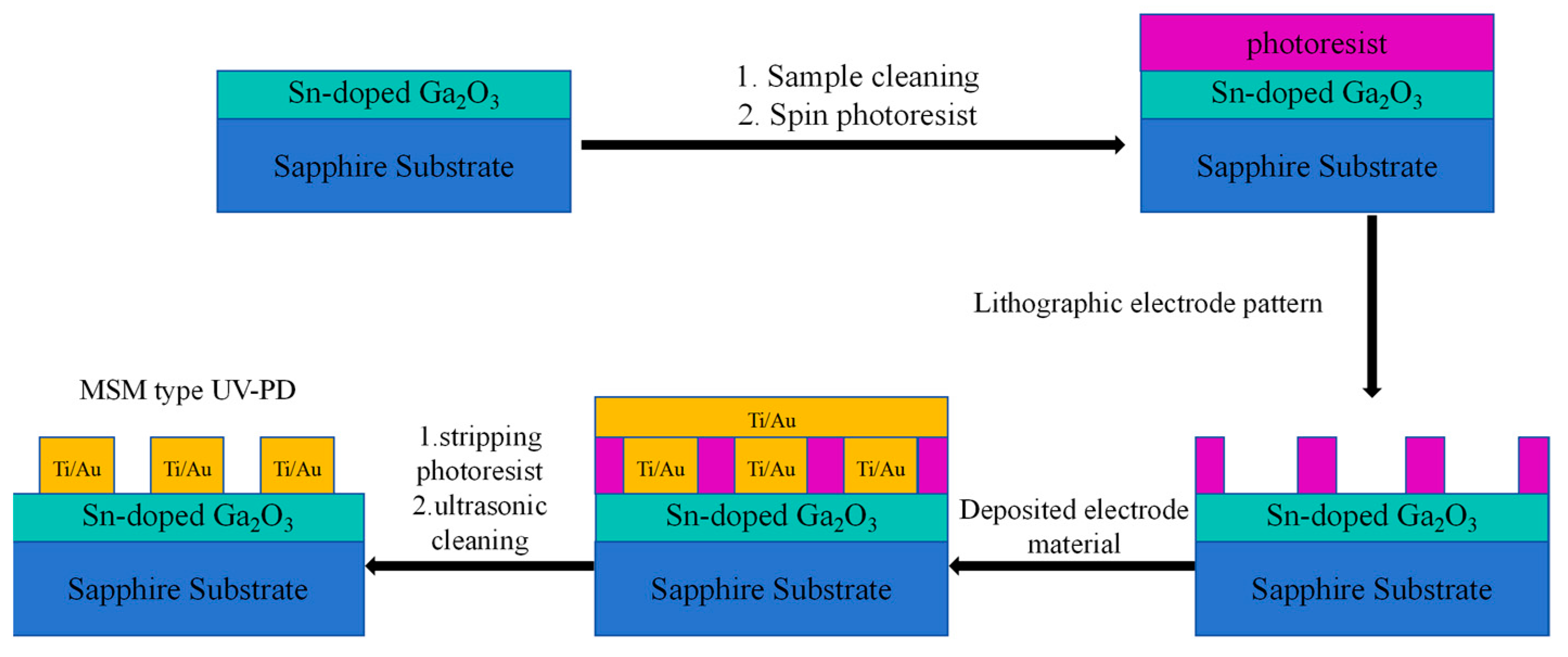
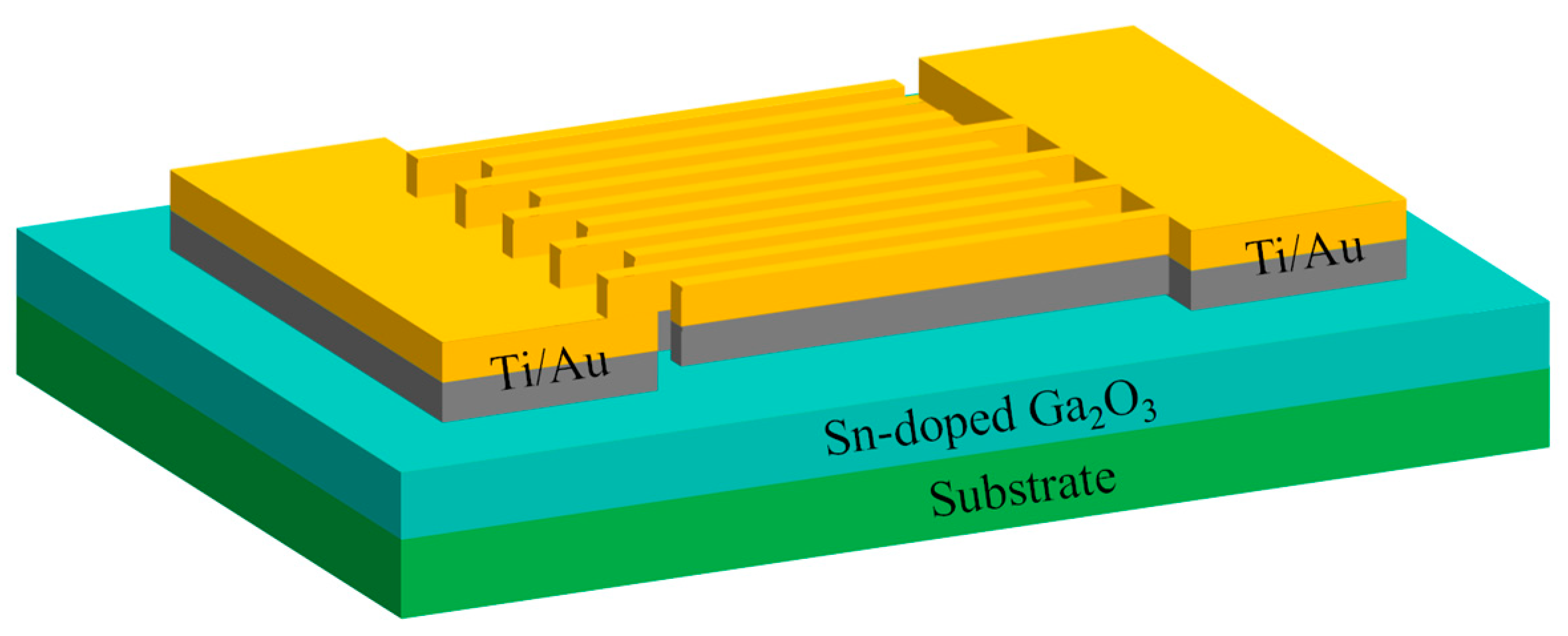
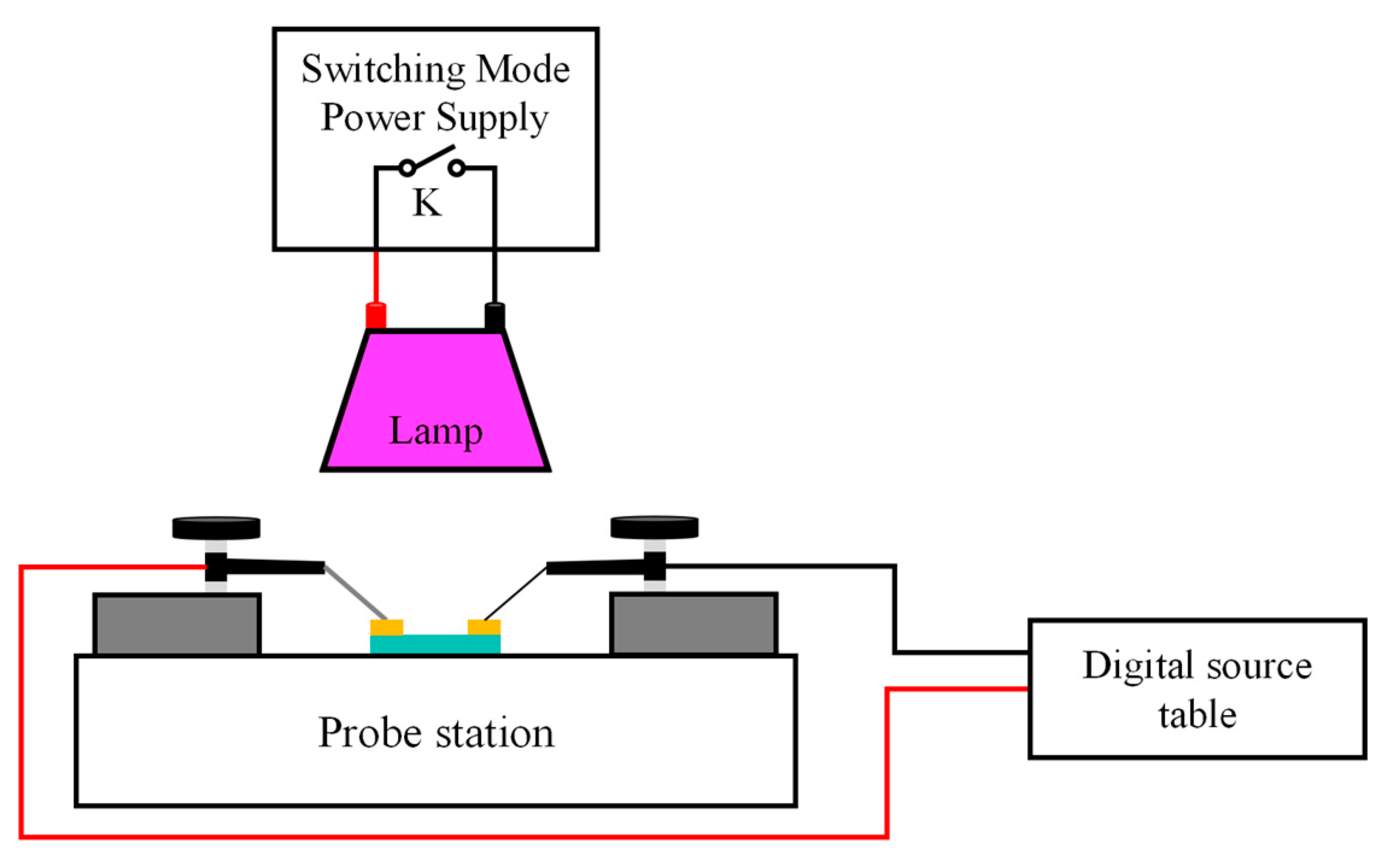

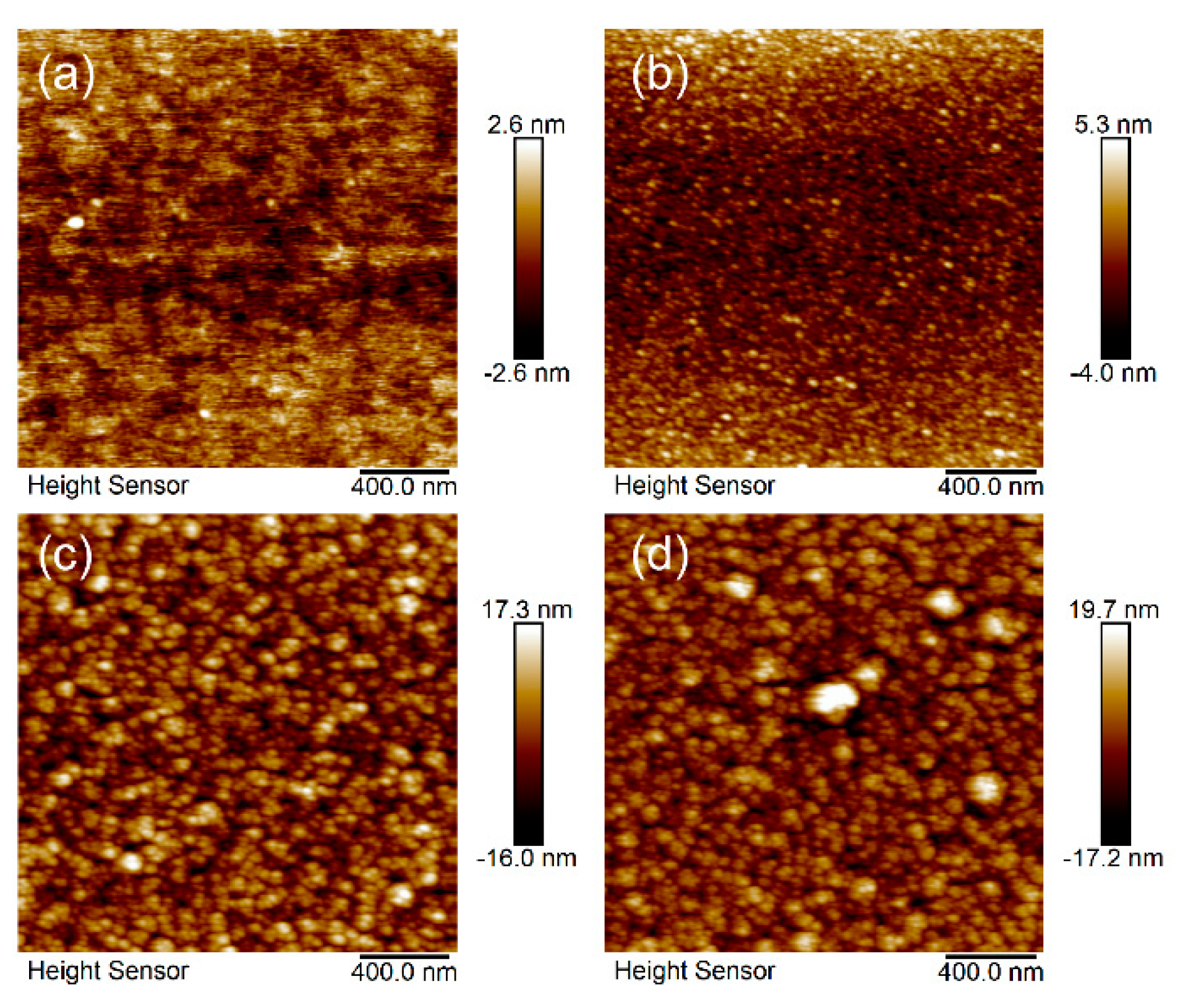
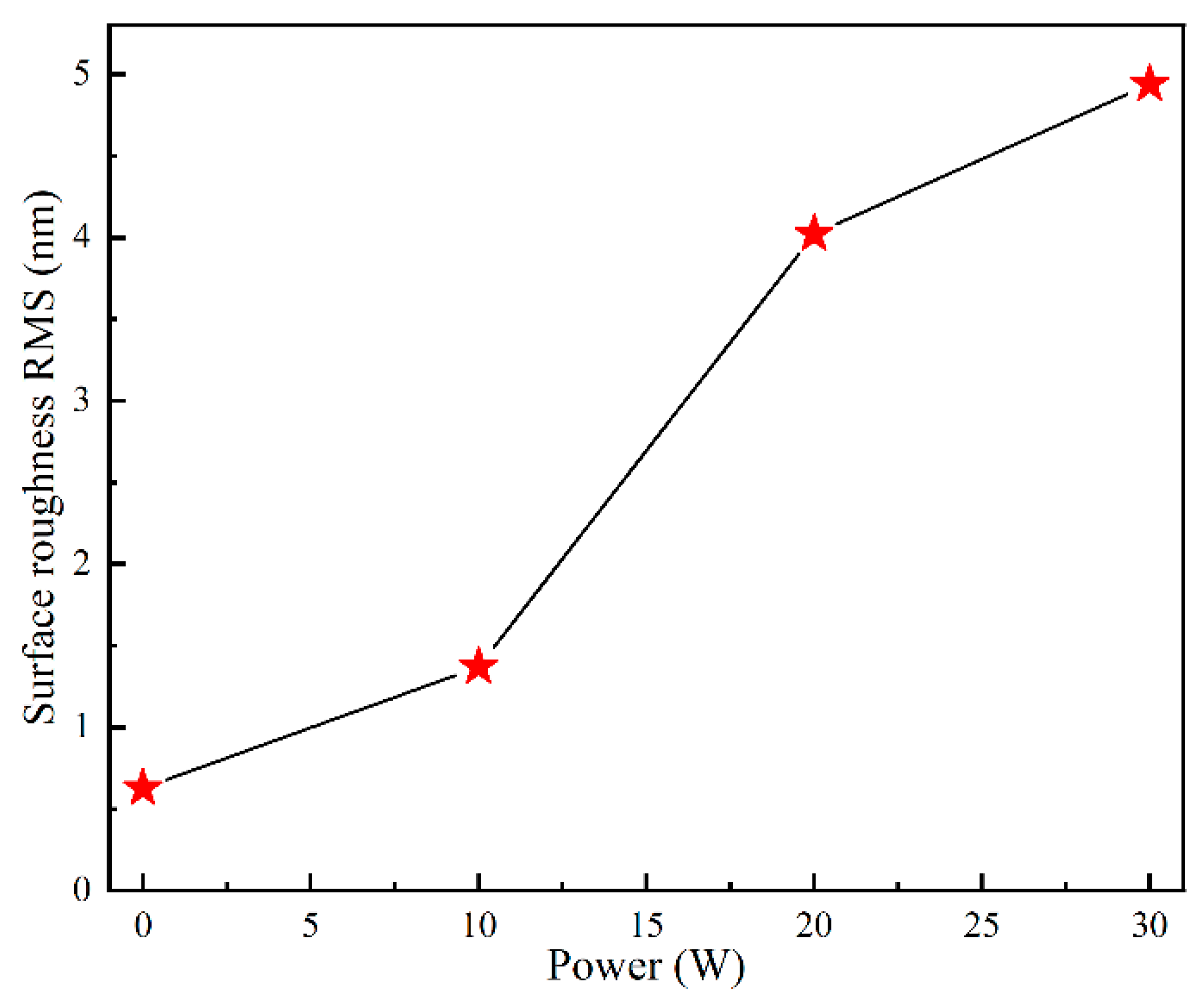


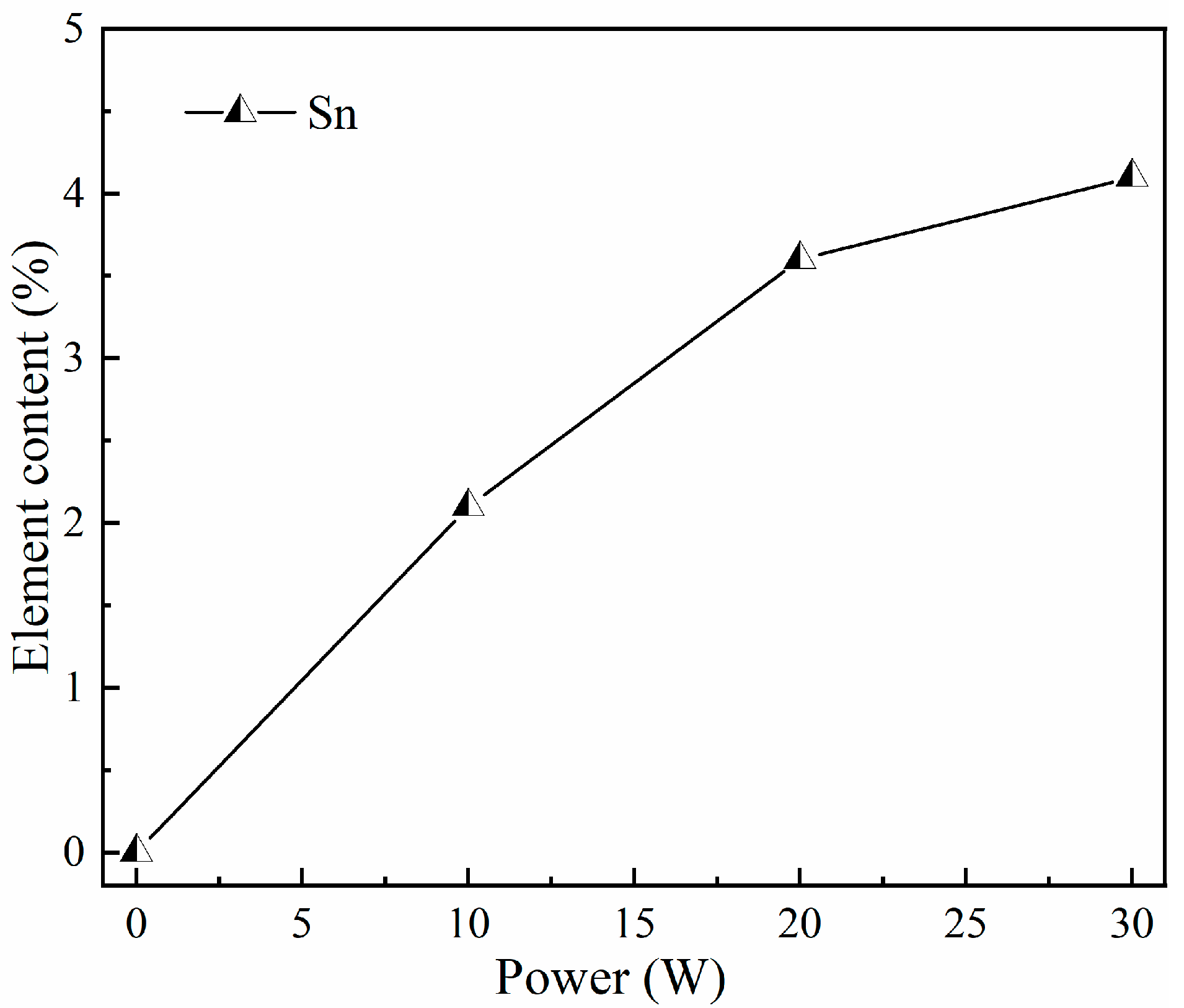
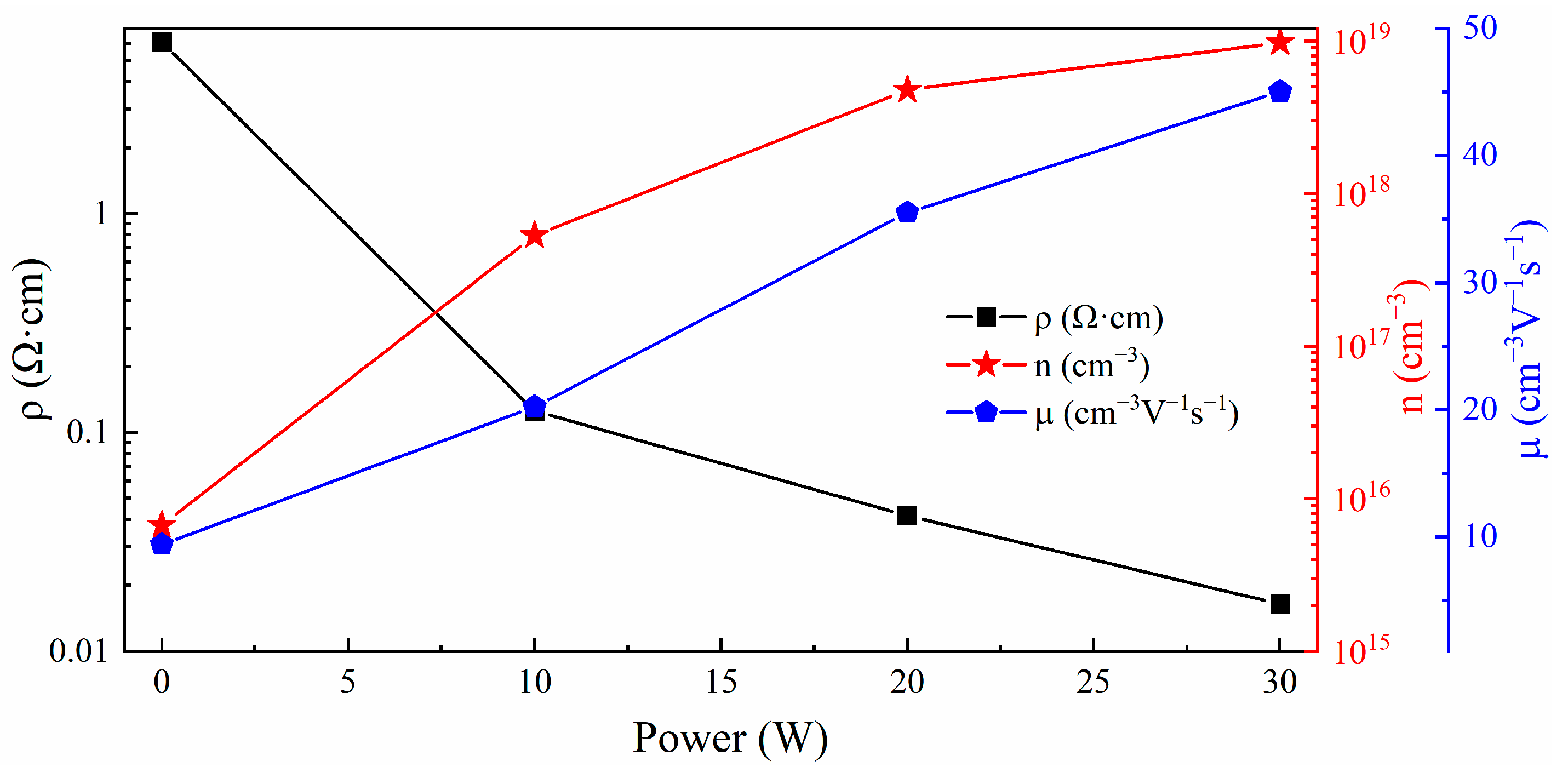
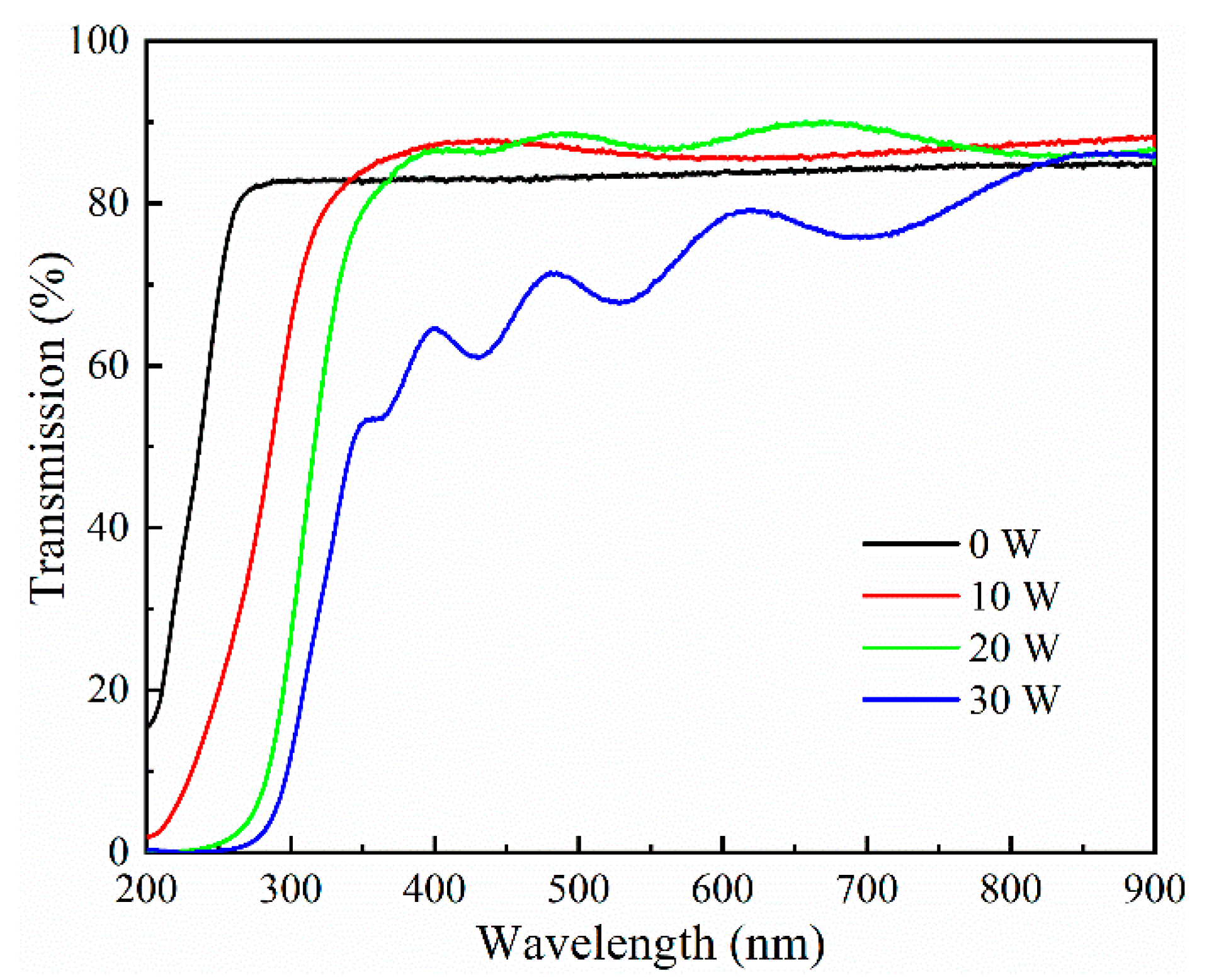
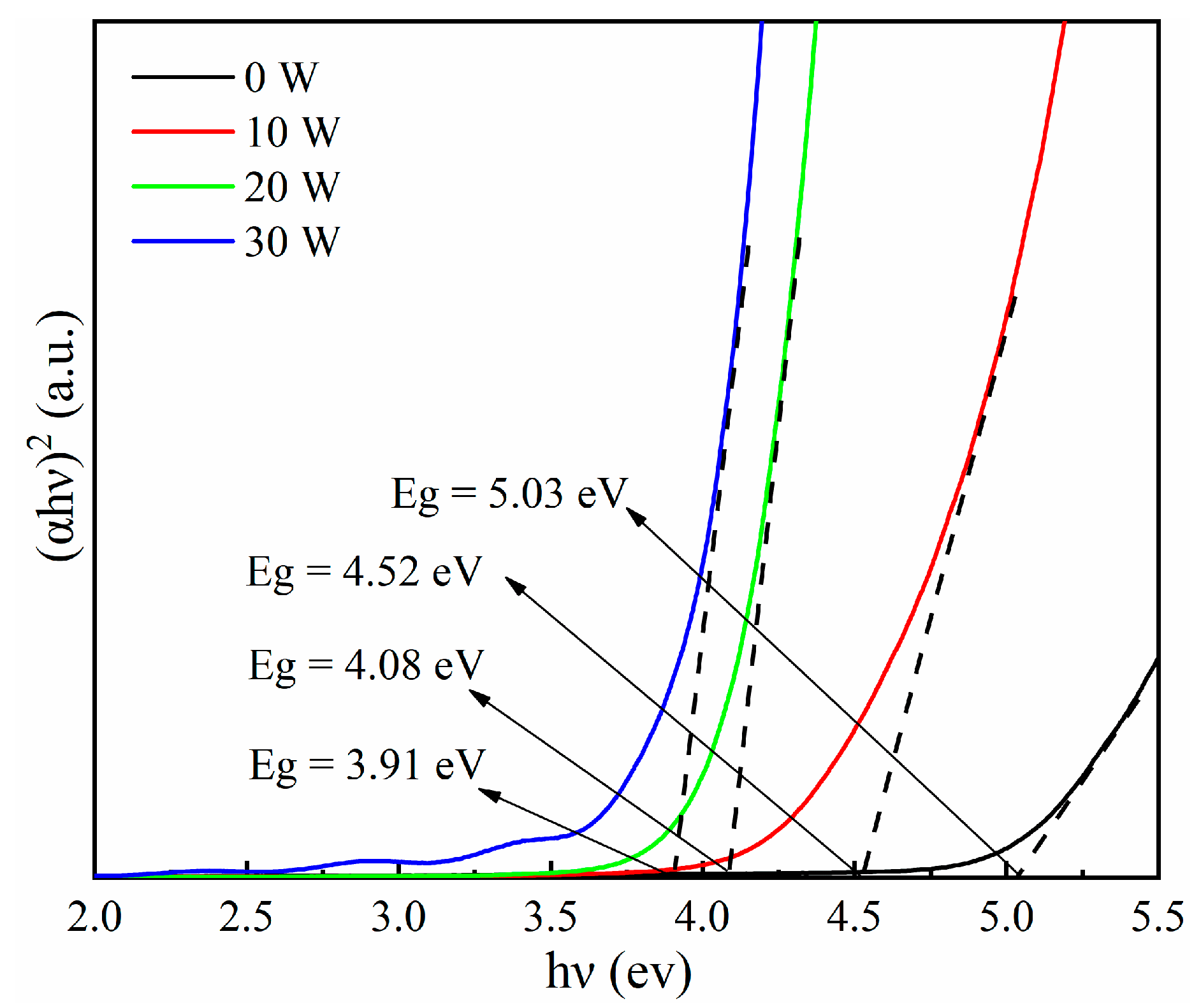
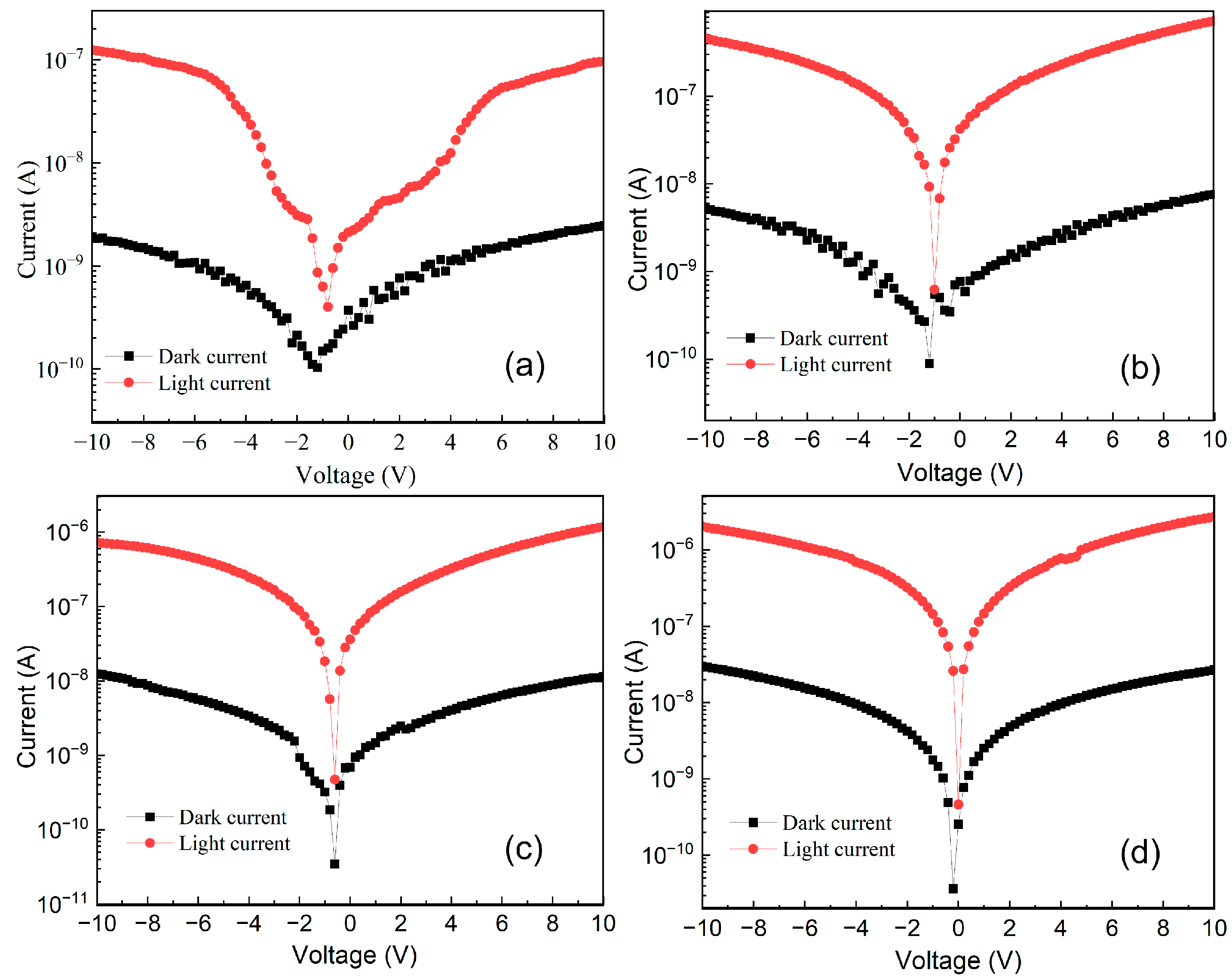
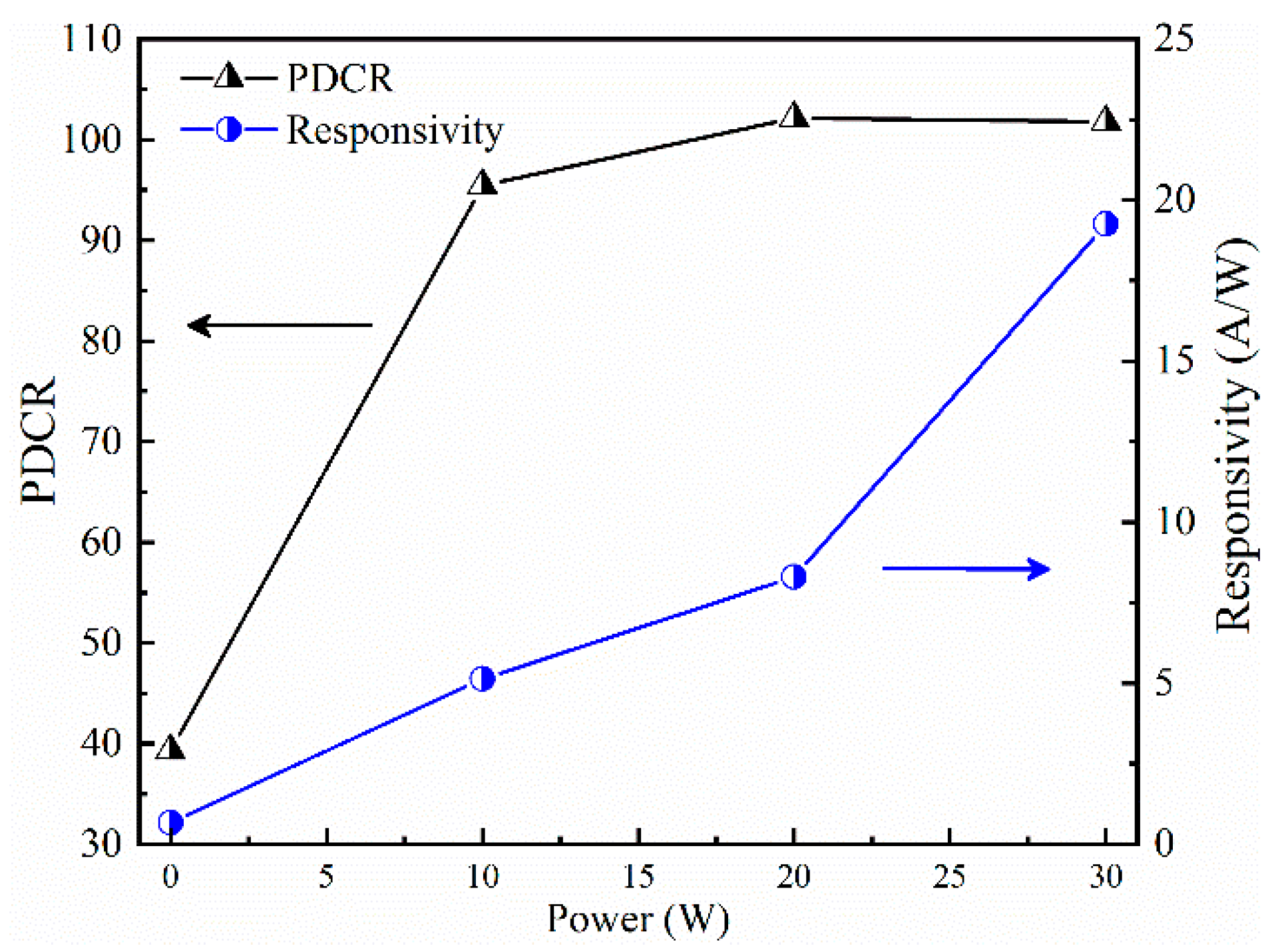
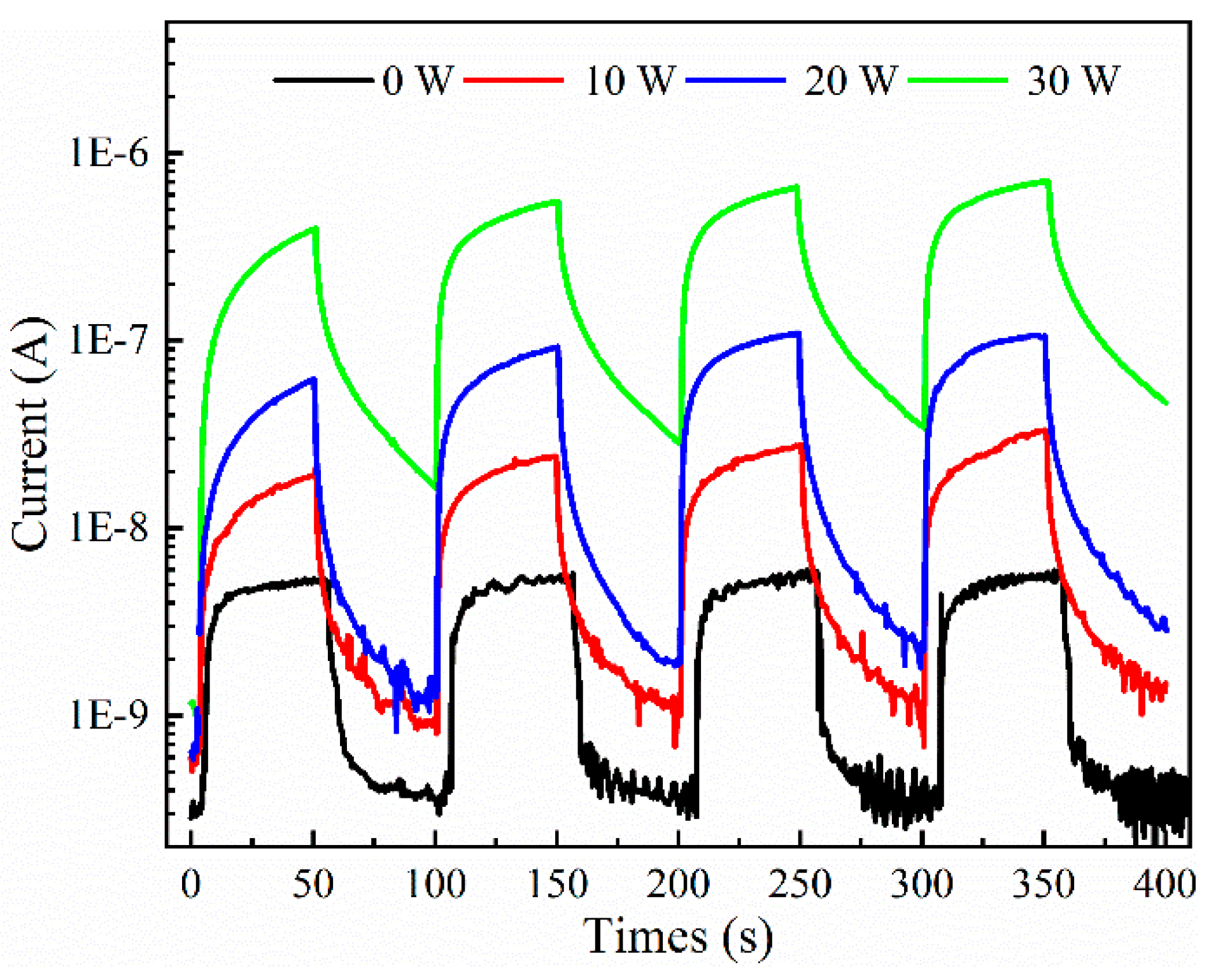

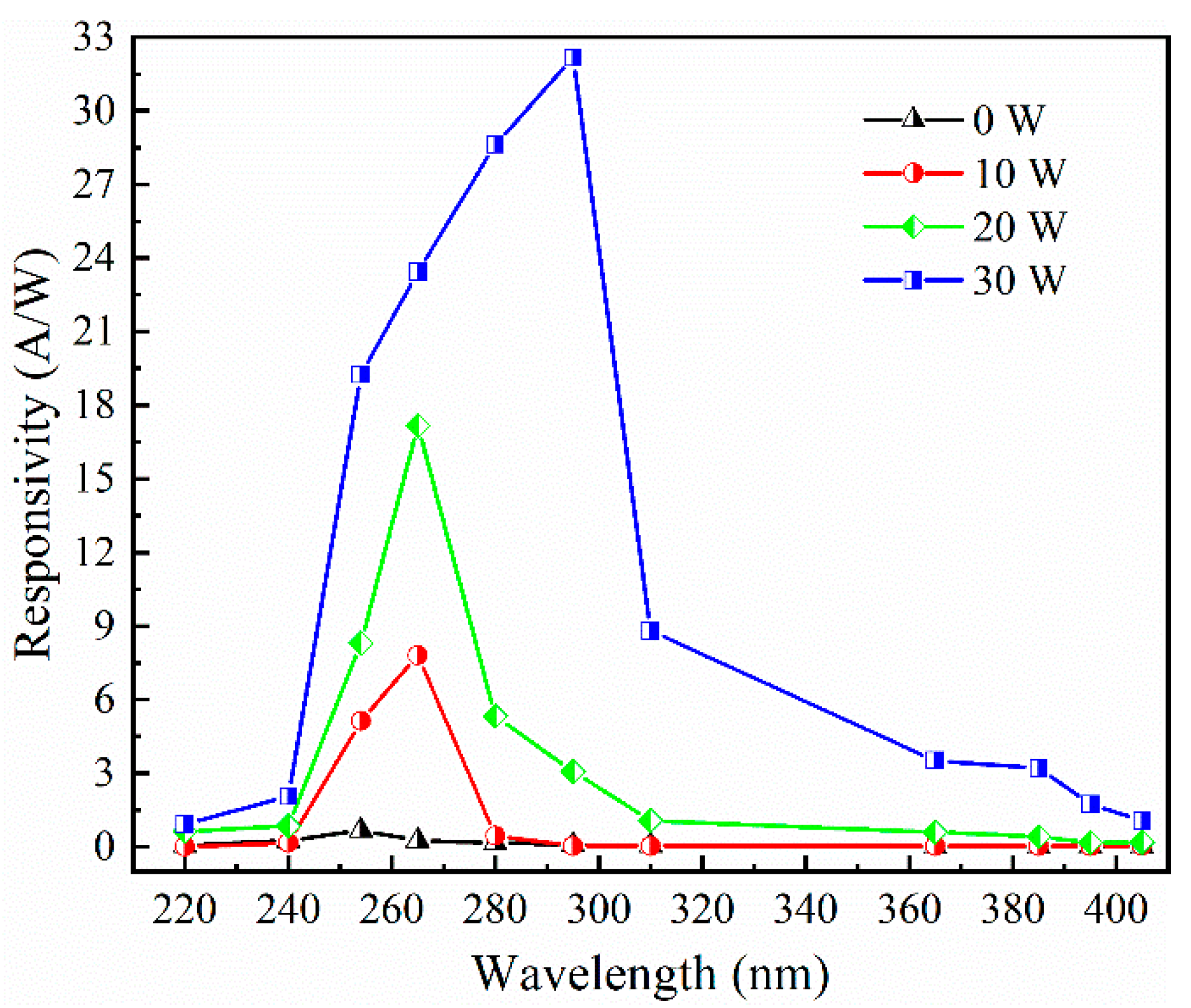
Disclaimer/Publisher’s Note: The statements, opinions and data contained in all publications are solely those of the individual author(s) and contributor(s) and not of MDPI and/or the editor(s). MDPI and/or the editor(s) disclaim responsibility for any injury to people or property resulting from any ideas, methods, instructions or products referred to in the content. |
© 2024 by the authors. Licensee MDPI, Basel, Switzerland. This article is an open access article distributed under the terms and conditions of the Creative Commons Attribution (CC BY) license (https://creativecommons.org/licenses/by/4.0/).
Share and Cite
Liu, Y.; Huang, R.; Lin, T.; Dang, J.; Huang, H.; Shi, J.; Chen, S. Preparation of Sn-Doped Ga2O3 Thin Films and MSM Ultraviolet Detectors Using Magnetron Co-Sputtering. Materials 2024, 17, 3227. https://doi.org/10.3390/ma17133227
Liu Y, Huang R, Lin T, Dang J, Huang H, Shi J, Chen S. Preparation of Sn-Doped Ga2O3 Thin Films and MSM Ultraviolet Detectors Using Magnetron Co-Sputtering. Materials. 2024; 17(13):3227. https://doi.org/10.3390/ma17133227
Chicago/Turabian StyleLiu, Yantao, Rong Huang, Tao Lin, Jiale Dang, Haoxiang Huang, Jiahao Shi, and Sui Chen. 2024. "Preparation of Sn-Doped Ga2O3 Thin Films and MSM Ultraviolet Detectors Using Magnetron Co-Sputtering" Materials 17, no. 13: 3227. https://doi.org/10.3390/ma17133227
APA StyleLiu, Y., Huang, R., Lin, T., Dang, J., Huang, H., Shi, J., & Chen, S. (2024). Preparation of Sn-Doped Ga2O3 Thin Films and MSM Ultraviolet Detectors Using Magnetron Co-Sputtering. Materials, 17(13), 3227. https://doi.org/10.3390/ma17133227




